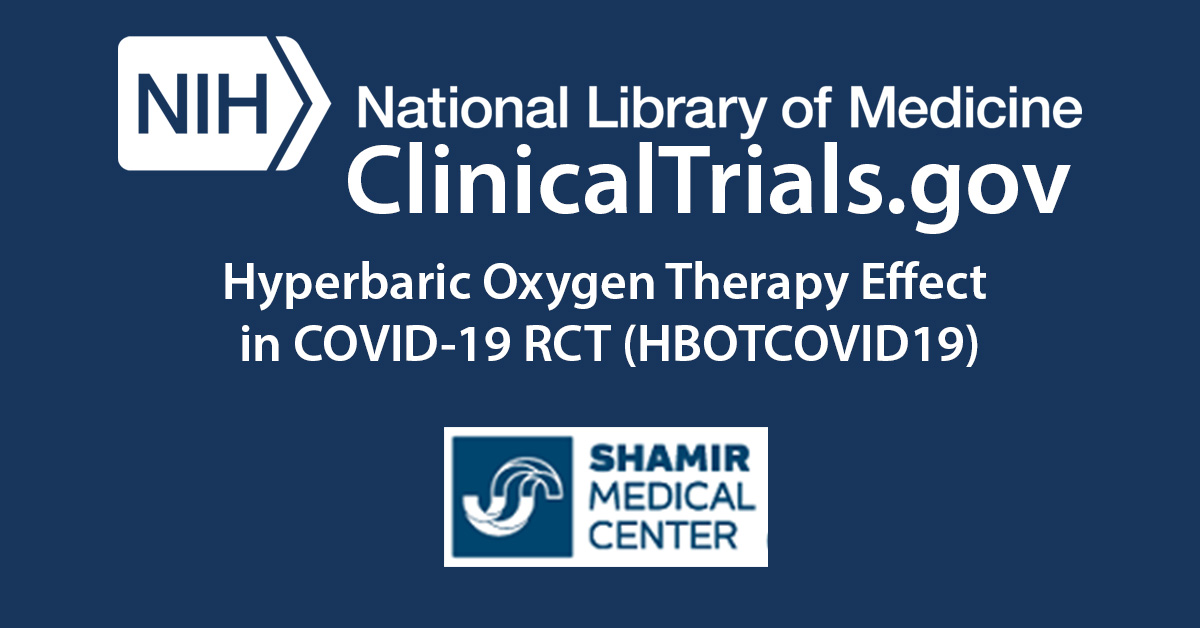
Amir Hadanny, MD and Shai Efrati, MD of The Sagol Center for Hyperbaric Medicine and Research at Shamir Medical Center (the largest hyperbaric treatment center worldwide) in Be’er Ya’akov, Israel has begun a new clinical trial to study the treatment of COVID-19 patients using Hyperbaric Oxygen Therapy.
The 2019-20 coronavirus disease, caused by COVID-19, is an ongoing pandemic. The outbreak started in Wuhan, Hubei province, China, in December 2019 and the World Health Organization (WHO) recognized it as a pandemic on 11 March 2020. Up to Apr 9. 2020 there are more than 2 million confirmed cases, and over 140,000 deaths. In Israel, COVID-19 was confirmed in more 12,000 cases and took the life of 140 victims. There are 323 mild admitted cases, 170 moderate admitted cases and 170 severe admitted cases (16.04.2020) .
Even though the general mortality rate is low (0.2-7%, country based), patients who develop Acute Respiratory Distress Syndrome (ARDS) have a significantly higher mortality rate, up to 61-90%. COVID-19 ARDS is different, causing a rapidly progressive disease including respiratory insufficiency and pulmonary fibrosis. The mechanism behind isn’t clear yet, but evidence points to the direction of an acute cytokines storm which include: IL-2, IL-7, GCSF, InterferonGamma, TNF-alpha, Macrophage chemoattractant protein . Poor prognosis include high levels of IL-6 and Ferritin.
More than 160 clinical trials have been registered, but as of April 2020, there is no proven effective treatment.
The use of hyperbaric oxygen therapy (HBOT) includes breathing 100% oxygen in pressures higher than 1 absolute atmospheres (ATA), increasing the amount of oxygen dissolved in the plasma and the different tissues. In the last month, Chen et al. reported a case series of 5 severe COVID-19 patients treated with 3-8 HBOT sessions in addition to the standard therapy. In all cases, they reported an increase in oxygen saturation, arterial oxygen content,lactate levels reduction,fibrinogen levels decrease and increase in lymphocytes number.In addition, the patients chest CT showed improved signs. Symptomatic relief started following the 2nd session. No significant adverse events were reported.
These findings may be explained by the known physiological effects of HBOT, related to the SARS-CoV-2 virus pathogenesis:
- Increased competitive binding of oxygen to the hemoglobin molecule – it has been postulated recently the SARS-CoV-2 bind to the heme component in the hemoglobin molecule and reduces the oxygen affinity to hemoglobin. During HBOT, the increased amount of available oxygen molecules increases the binding to the hemoglobin molecules. This has shown significant beneficial effects in cases of another competitive molecule such as carbon monoxide intoxication.
- Tissue oxygenation – The oxygen content in the different tissues is multiplied by 25-30 times. This effect has two therapeutic aspects: First, overcoming pulmonary hypoxia (either shunt or VQ mismatch) by increasing the FiO2 significantly. By increasing the pulmonary oxygen gradient, oxygen diffusion increases and can overcome the inflammation in the alveoli and the thickened fibrosis caused by ARDS. Second, during HBOT, the amount of oxygen dissolved in the plasma becomes significant and enables tissue oxygenation without the need of red blood cells.
- Anti inflammatory – HBOT reduces the following inflammatory cytokines both in the protein level and genes expression (mRNA): IL-2, TNF-alpha, IL-6, IL-1beta. The anti-inflammatory effect has been shown in chronic diseases as well as models of acute infection and massive hemorrhage.
The purpose of the current study is the evaluate the efficacy of HBOT in moderate-severe COVID-19 patients in a randomized controlled manner.
Protocol Following signing an informed consent, the patients will be randomized 2:1 to hyperbaric oxygen therapy group and normobaric oxygen therapy grou. Following the randomization the patients will undergo evaluation including symptoms, vitals, pulmonary function, blood tests.
The patients will undergo 8 sessions of either hyperbaric/normobaric oxygen therapy, 2 sessions per day, in 4 consecutive days.During the sessions, the symptoms and vitals will be monitored. 1 day and 1 week following the last session, revaluation will be performed.
For more information on the trial, visit: https://clinicaltrials.gov/ct2/show/NCT04358926
